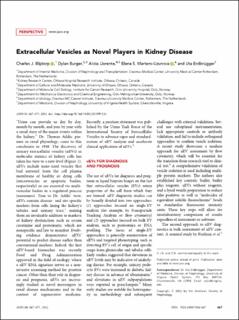| dc.contributor.author | Blijdorp, Charles J. | |
| dc.contributor.author | Burger, Dylan | |
| dc.contributor.author | Llorente, Alicia | |
| dc.contributor.author | Martens-Uzunova, Elena S. | |
| dc.contributor.author | Erdbrügger, Uta | |
| dc.date.accessioned | 2022-12-23T08:25:27Z | |
| dc.date.available | 2022-12-23T08:25:27Z | |
| dc.date.created | 2022-05-25T11:02:42Z | |
| dc.date.issued | 2022-02-28 | |
| dc.identifier.citation | Journal of the American Society of Nephrology. 2022, 33 (3), 467-471. | en_US |
| dc.identifier.issn | 1046-6673 | |
| dc.identifier.issn | 1533-3450 | |
| dc.identifier.uri | https://hdl.handle.net/11250/3039312 | |
| dc.description.abstract | “Urine can provide us day by day, month by month, and year by year with a serial story of the major events within the kidney.” Dr. Thomas Addis, pioneer in renal physiology, came to this conclusion in 1948. The discovery of urinary extracellular vesicles (uEVs) as molecular mimics of kidney cells has taken his view to a new level (Figure 1). uEVs include nano-sized vesicles that bud outward from the cell plasma membrane of healthy or dying cells (microvesicles or apoptotic bodies, respectively) or are excreted via multivesicular bodies in a regulated process (exosomes). True to Dr. Addis’ view, uEVs contain disease- and site-specific markers from cells lining the kidney’s tubules and urinary tract,1 making them an invaluable addition to markers of kidney dysfunction such as serum creatinine and proteinuria, which are nonspecific and late to manifest. Evolving evidence demonstrates uEVs’ potential to predict disease earlier than conventional markers. Indeed, the first uEV-based biomarker was recently Food and Drug Administration approved in the field of urology, where a uEV RNA signature serves as a noninvasive screening method for prostate cancer. Other than their role in diagnosis and prognosis, uEVs are increasingly studied as novel messengers in renal disease mechanisms and in the context of regenerative medicine. Recently, a position statement was published by the Urine Task Force of the International Society of Extracellular Vesicles to advance rigor and standardization of uEV analysis and accelerate clinical application of uEVs. | en_US |
| dc.language.iso | eng | en_US |
| dc.publisher | American Society of Nephrology | en_US |
| dc.relation.ispartofseries | Journal of the American Society of Nephrology;Vol. 33, Issue 3 | |
| dc.subject | Exosomes | en_US |
| dc.subject | Extracellular vesicles | en_US |
| dc.subject | Biomarkers | en_US |
| dc.subject | Regeneration | en_US |
| dc.subject | Cell signaling | en_US |
| dc.title | Extracellular Vesicles as Novel Players in Kidney Disease | en_US |
| dc.type | Peer reviewed | en_US |
| dc.type | Journal article | en_US |
| dc.description.version | publishedVersion | en_US |
| dc.rights.holder | © 2022 by the American Society of Nephrology | en_US |
| cristin.ispublished | true | |
| cristin.fulltext | original | |
| cristin.qualitycode | 2 | |
| dc.identifier.doi | https://doi.org/10.1681/ASN.2021091232 | |
| dc.identifier.cristin | 2027280 | |
| dc.source.journal | Journal of the American Society of Nephrology | en_US |
| dc.source.volume | 33 | en_US |
| dc.source.issue | 3 | en_US |
| dc.source.pagenumber | 467-471 | en_US |
